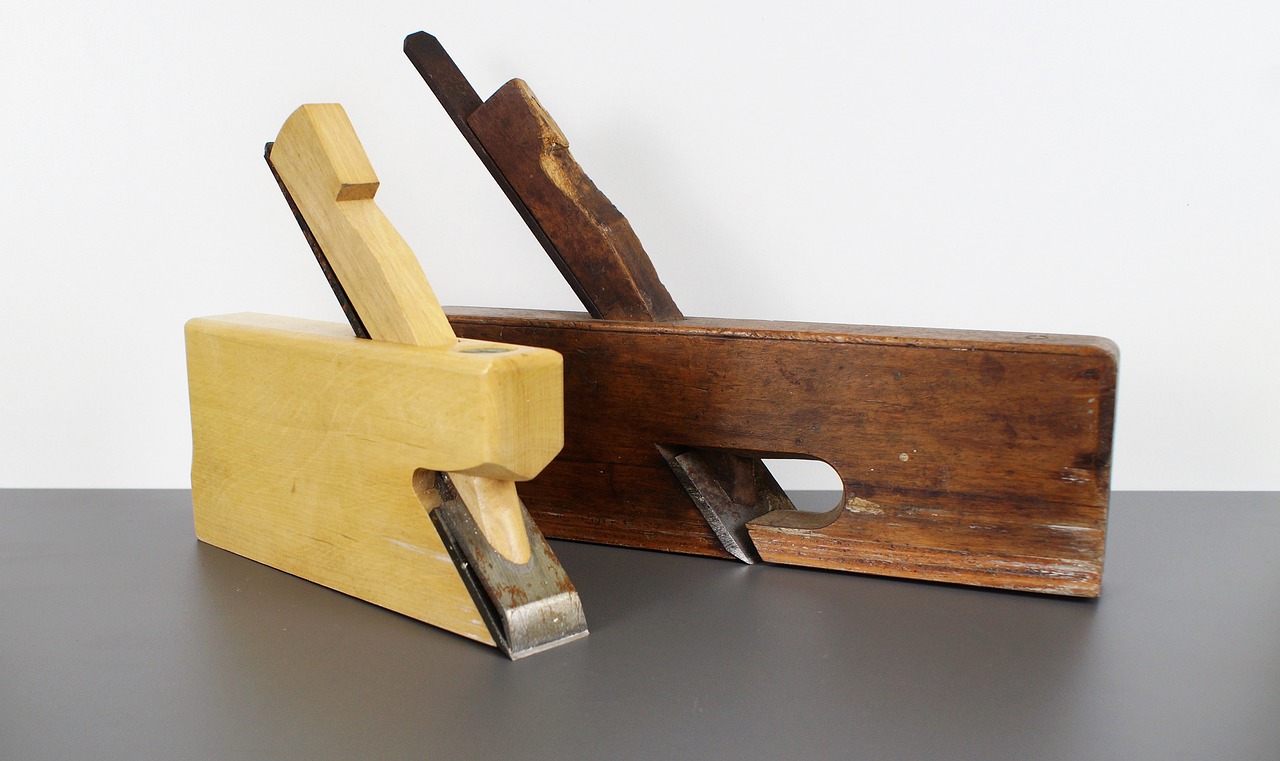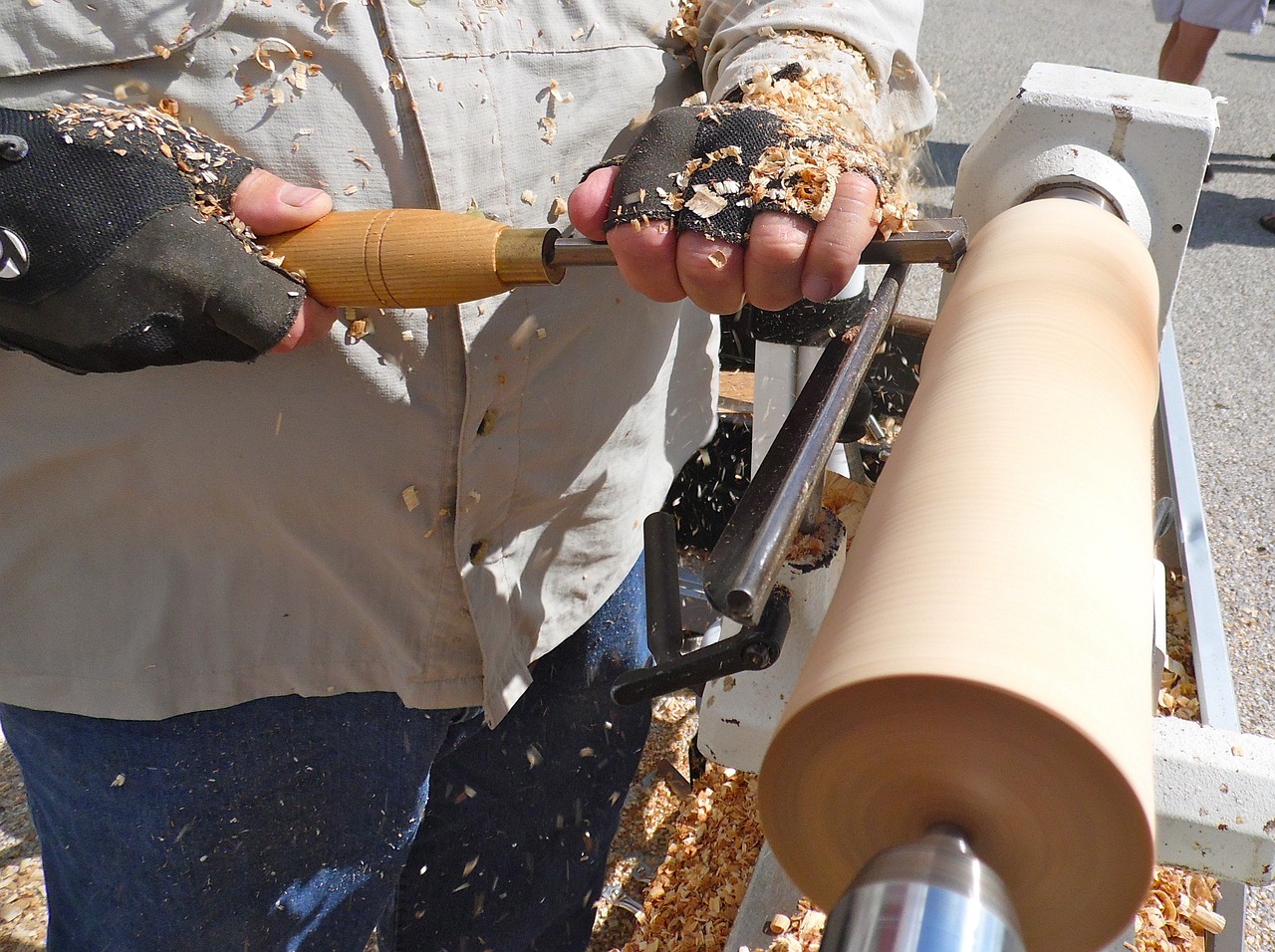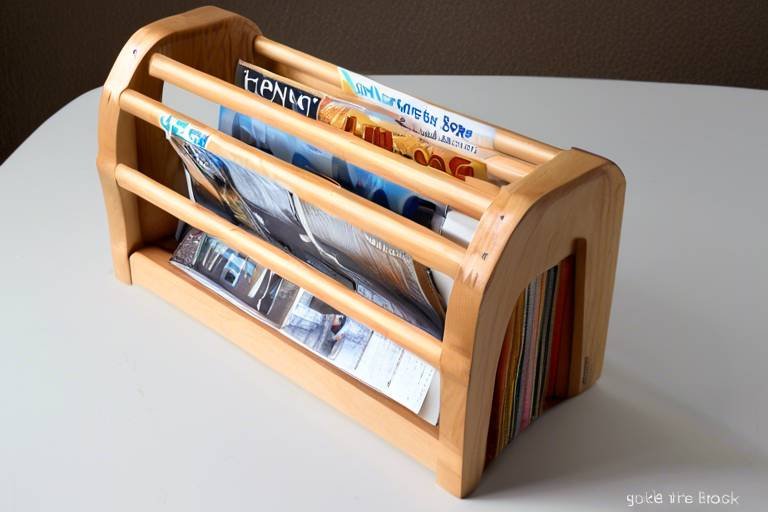Woodworking for Wellness: The Therapeutic Value of Wood Crafts
Have you ever felt the soothing sensation of working with your hands, watching a piece of raw wood transform into something beautiful? Woodworking is more than just a hobby; it’s a journey into a world of creativity and mindfulness that can significantly enhance your mental and physical health. In today's fast-paced world, where stress and anxiety seem to lurk around every corner, engaging in woodworking can serve as a powerful antidote. This article explores the myriad benefits of woodworking, illuminating its therapeutic aspects, the creative process involved, and how it can elevate your overall well-being.
Engaging in woodworking can significantly reduce stress and anxiety, providing a mindful escape from the chaos of everyday life. When you're engrossed in shaping, sanding, or assembling pieces of wood, your mind shifts focus, allowing for a moment of clarity. This act of creating fosters not only mental clarity but also emotional stability. Think of it as a form of meditation, where each cut and each stroke of sandpaper brings you closer to a peaceful state of mind. The rhythmic motions and the tactile nature of the materials can ground you, helping to alleviate racing thoughts and overwhelming feelings.
Woodworking nurtures creativity while also promoting physical health in various ways. It’s not just about making beautiful furniture or crafts; it’s a full-body workout in disguise! The physical benefits include improved hand-eye coordination, increased strength, and enhanced fine motor skills gained through various woodworking tasks. Each project you undertake challenges your body and mind, leading to a healthier lifestyle. So, let’s dive deeper into how these physical advantages manifest.
When you work with tools and materials, you naturally enhance your dexterity and coordination. Imagine the precision required to make intricate cuts or to assemble a complicated joint; these skills translate into daily activities, making tasks like typing or playing a musical instrument easier. As you hone your woodworking skills, you’re also training your body to move with greater finesse. This newfound dexterity doesn’t just stay in the workshop; it spills over into your everyday life, enhancing your overall physical health.
Woodworking is an excellent way to exercise your hand muscles, leading to better grip and strength. When you’re chiseling or hammering, you're engaging muscles that might otherwise go unnoticed. Over time, this practice can improve your grip strength, which is essential for various activities, from carrying groceries to playing sports. Techniques such as repetitive sanding or using hand tools can particularly help in muscle development. So, next time you pick up a tool, remember you’re not just crafting; you’re also working out!
Proper woodworking techniques encourage good posture and core engagement. When you stand correctly while working on a project, you not only protect your back but also strengthen your core. Maintaining the right stance during projects can significantly benefit your overall body alignment. Think of it as a workout for your posture; the more you practice, the better you become. This is crucial, especially in a world where many of us spend hours hunched over screens. Woodworking gives you a reason to stand tall and work with intention.
Woodworking encourages a state of mindfulness, promoting focus and concentration. When you immerse yourself in crafting, it can lead to a meditative experience, helping to clear your mind and sharpen your mental faculties. As you concentrate on the task at hand, you may find that your worries fade away, leaving only the satisfying sound of saws and the smell of fresh wood. This focus can have lasting effects on your mental clarity, making it easier to tackle challenges both in and out of the workshop.
Woodworking can also foster connections with others, whether through classes or collaborative projects. The social benefits of woodworking are often overlooked but are incredibly valuable. By engaging with fellow woodworkers, you not only share knowledge but also build a community that supports and inspires creativity. This sense of belonging can significantly enhance your overall well-being, reminding you that you’re not alone in your journey.
Participating in woodworking groups can enhance social interaction and provide a sense of community. These groups often share tips, techniques, and experiences, creating a rich tapestry of learning and growth. The support found in these communities can be a game-changer, especially for beginners who may feel intimidated. It’s like having a family of woodworkers who cheer you on as you embark on your crafting journey!
Working on projects with friends or family can strengthen relationships. Imagine spending a weekend building a birdhouse with your kids or crafting a coffee table with a friend. These collaborative woodworking endeavors create lasting memories and connections that go beyond the finished product. The laughter, the shared challenges, and the sense of achievement can bond you in ways that are both profound and enjoyable.
- What are the best tools for beginners in woodworking? Start with basic hand tools like a saw, hammer, and measuring tape.
- Can woodworking really help with stress relief? Absolutely! The focus and creativity involved can significantly reduce stress.
- Is woodworking safe for children? With proper supervision and age-appropriate tools, woodworking can be a fun and educational activity for kids.

The Psychological Benefits of Woodworking
Engaging in woodworking is more than just a hobby; it’s a profound way to cultivate mental clarity and emotional stability. Imagine yourself in a serene workshop, the gentle sound of tools interacting with wood, and the earthy scent of freshly cut timber enveloping you. This environment fosters a unique form of mindfulness that allows you to escape the chaotic demands of everyday life. It’s like stepping into a sanctuary where stress and anxiety fade away, replaced by a sense of purpose and creation.
One of the most remarkable aspects of woodworking is its ability to provide a mindful escape. When you engage in crafting, your mind transitions from the noise of daily worries to the rhythmic motions of shaping wood. This process can be incredibly therapeutic, as it allows you to focus solely on the task at hand. Here are some psychological benefits you can expect:
- Stress Reduction: The act of working with your hands can significantly lower cortisol levels, the hormone associated with stress.
- Enhanced Creativity: Woodworking encourages creative thinking and problem-solving as you navigate through design and construction challenges.
- Improved Self-Esteem: Completing a project gives you a sense of accomplishment, boosting your confidence and self-worth.
Moreover, the creative process involved in woodworking is akin to a dance between imagination and reality. As you sketch your designs and visualize the final product, you’re essentially engaging in a form of mental exercise. This not only stimulates your brain but also enhances your ability to concentrate and focus. Think of it as a workout for your mind, where each cut and joint reinforces your cognitive abilities.
Woodworking also encourages a state of flow, a psychological phenomenon where you become fully immersed in an activity. When you're in this state, time seems to disappear, and you find yourself completely absorbed in the creative process. This experience can be incredibly fulfilling, as it allows you to connect with your inner self and express your thoughts and feelings through your craft.
Furthermore, the sense of community that often accompanies woodworking can amplify these psychological benefits. Whether you’re taking a class or joining a local woodworking group, the interactions with fellow crafters can provide a social support system that enhances your emotional well-being. Sharing ideas, techniques, and experiences creates bonds that can lead to lasting friendships, enriching your life in ways you might not have anticipated.
In conclusion, woodworking is not just about creating beautiful pieces of art; it's a journey toward mental wellness. By immersing yourself in the craft, you can unlock a treasure trove of psychological benefits that promote relaxation, creativity, and community connection. So, why not grab some wood and tools today? You might just discover a new path to happiness!

Physical Health Advantages
When you think about woodworking, your mind might immediately jump to the beautiful pieces of furniture or art that can be created. However, the of engaging in this craft are just as impressive. Woodworking is not merely a creative outlet; it’s a full-body workout that can improve various aspects of your physical health. Imagine picking up a chisel, feeling the weight of it in your hand, and knowing that with every cut, you're not just shaping wood, but also enhancing your body’s capabilities.
One of the most significant benefits of woodworking is the improvement in hand-eye coordination. When you're maneuvering tools and materials, you're training your brain and body to work together in harmony. This coordination is not just beneficial in the workshop; it translates into everyday activities. For instance, think about how much easier it becomes to perform tasks like typing, playing sports, or even cooking when your hand-eye coordination is sharp. Additionally, the repetitive motions involved in woodworking can lead to enhanced fine motor skills, which are crucial for tasks requiring precision.
As you delve deeper into woodworking, you’ll notice a marked improvement in your dexterity. This is not just about being able to hold a tool correctly; it’s about developing a finesse that allows you to execute intricate designs and details. The more you practice, the more your brain establishes pathways that enhance your overall coordination. This improvement can be likened to a musician mastering their instrument—each stroke of the tool becomes more fluid, more intentional.
Woodworking is also a fantastic way to strengthen your hand muscles. The act of gripping tools, pushing saws, and chiseling wood engages various muscle groups in your hands and forearms. Over time, this can lead to a noticeable increase in grip strength, which is beneficial for a multitude of activities. Techniques like carving or sanding can serve as excellent workouts for your hands. Think of it as a gym session for your fingers; each project is an opportunity to build strength and endurance.
Another physical advantage of woodworking is the emphasis it places on proper posture and core strength. Many woodworking tasks require you to stand, bend, or reach in ways that naturally engage your core muscles. By maintaining the right stance and using your body correctly, you not only protect yourself from injury but also promote better body alignment. Imagine standing tall, with your core engaged, as you cut through a piece of wood—this posture not only supports your back but also enhances your overall strength and stability.
Finally, let’s talk about how woodworking encourages a state of mindfulness. When you immerse yourself in crafting, you enter a meditative state that promotes focus and concentration. This mental clarity is essential, not just for the task at hand, but for your overall well-being. Engaging in woodworking allows you to escape from the hustle and bustle of daily life, leading to a deeper connection with your surroundings and a more profound sense of accomplishment.
In conclusion, the physical health advantages of woodworking are vast and varied. From improved coordination and dexterity to enhanced strength and posture, this craft offers a holistic approach to maintaining and improving physical health. So, the next time you pick up a tool, remember that you’re not just creating; you’re also crafting a healthier you.
- What are the main physical benefits of woodworking? Woodworking improves hand-eye coordination, strengthens hand muscles, enhances posture, and promotes overall physical fitness.
- Can woodworking help with stress relief? Yes, engaging in woodworking can provide a mindful escape, reducing stress and anxiety.
- Do I need prior experience to start woodworking? Not at all! Many woodworking classes are designed for beginners, making it accessible for everyone.
- How can I find a woodworking community? Look for local woodworking classes, workshops, or online forums where enthusiasts gather to share their passion.

Improved Dexterity and Coordination
When you dive into the world of woodworking, you're not just creating beautiful pieces of art; you're also sharpening your dexterity and coordination. Imagine your hands moving expertly over various tools and materials, each cut and joint bringing you closer to your finished masterpiece. As you engage in this craft, you're developing fine motor skills that are essential not only in woodworking but in everyday life. Think of it as a workout for your hands and fingers, where every saw stroke and chisel push is an exercise in precision and control.
The beauty of woodworking lies in its intricate tasks, which require you to be fully present and engaged. Each project presents a unique challenge that demands a level of focus that can only be achieved through practice. For instance, when you're sanding a piece of wood to achieve that smooth finish, you're not just making it look good; you're also honing your hand-eye coordination. Your brain is constantly communicating with your hands, guiding them to make the necessary adjustments. This process can be likened to playing a musical instrument, where every note requires the right finger placement and timing.
Moreover, the skills you develop in woodworking can translate seamlessly into other areas of your life. Improved dexterity can enhance your ability to perform tasks such as typing, playing sports, or even cooking. Have you ever tried to slice vegetables neatly? It’s all about that coordination! The more you practice woodworking, the more you’ll notice how these skills spill over into your daily activities, making you more adept and confident in everything you do.
Additionally, the act of working with various tools—like chisels, saws, and drills—provides a fantastic opportunity to understand how to manage different motions and grips. Each tool requires a unique approach, and mastering them can lead to a sense of accomplishment that boosts your confidence. You might even find yourself surprising others with your newfound skills, whether it’s impressing friends with your woodworking projects or simply showcasing your improved dexterity in other hobbies.
In essence, woodworking is more than just a creative outlet; it’s a pathway to enhancing your physical capabilities. As you embark on this journey, you’ll discover that the benefits of improved dexterity and coordination are far-reaching, enriching your life in ways you might not have anticipated. So, grab those tools and let your hands do the talking—your body will thank you for it!
- What tools do I need to start woodworking? You can begin with basic tools such as a saw, hammer, chisel, and measuring tape.
- Is woodworking safe for beginners? Yes, as long as you follow safety guidelines and use tools properly.
- How long does it take to become skilled at woodworking? Skill development varies, but consistent practice will lead to improvement over time.
- Can woodworking be a solo activity? Absolutely! Many enjoy woodworking alone, but it can also be a fantastic group activity.
- What are some common projects for beginners? Simple projects like birdhouses, shelves, or small furniture pieces are great starting points.

Strengthening Hand Muscles
Engaging in woodworking is not just about creating beautiful pieces of art; it’s also a fantastic way to strengthen your hand muscles. Each time you grasp a tool, whether it's a chisel, saw, or drill, you're putting your hand muscles to work. This repetitive motion is akin to a workout, but instead of lifting weights, you're crafting something tangible and useful. Over time, these activities lead to improved grip strength, which can enhance your overall dexterity and functionality in daily tasks.
Consider this: when you’re shaping wood, your fingers are constantly engaging in a series of movements that require both strength and precision. This is especially true when performing intricate tasks such as carving or detailed sanding. As you push against the wood or pull the saw through, you’re not just creating; you’re also building muscle. This is the beauty of woodworking—it’s a productive way to exercise without even realizing it!
Moreover, the benefits extend beyond just muscle strength. Regular woodworking can help in developing fine motor skills, which are essential for various activities in life, from typing to playing musical instruments. The more you practice your craft, the more adept you become at controlling your hand movements, leading to enhanced coordination. It’s like playing a musical instrument; the more you practice, the more fluid and skilled you become.
To illustrate the impact of woodworking on hand muscle strength, here’s a simple table highlighting the different woodworking activities and their corresponding benefits:
| Woodworking Activity | Muscle Group Targeted | Benefits |
|---|---|---|
| Carving | Fingers and wrists | Improves dexterity and grip strength |
| Sawing | Forearm and hand | Enhances muscle endurance and coordination |
| Sanding | Fingers and palms | Develops fine motor skills and tactile sensitivity |
| Drilling | Hand and wrist | Strengthens grip and wrist stability |
In addition to these benefits, woodworking can also be a therapeutic activity. As you focus on the task at hand, you may find that your mind begins to clear, allowing you to escape from the stresses of daily life. This combination of physical exercise and mental relaxation creates a holistic approach to wellness that is hard to match. So, the next time you pick up your tools, remember that you’re not just crafting a piece of furniture or a decorative item; you’re also investing in your physical health.
- How often should I practice woodworking to see muscle benefits? Regular practice, even a few hours a week, can lead to noticeable improvements in muscle strength and coordination.
- What tools are best for beginners to strengthen hand muscles? Start with basic hand tools like chisels and saws, as they require more manual effort and help build strength.
- Can woodworking help with rehabilitation after an injury? Yes, woodworking can be an excellent rehabilitation activity, as it promotes hand function and encourages muscle recovery.

Enhancing Posture and Core Strength
When you dive into woodworking, you might not realize that you're not just crafting beautiful pieces of art; you're also giving your body a workout that can significantly enhance your posture and core strength. Have you ever noticed how professional woodworkers seem to have a certain poise? That’s not just from years of experience; it's also a result of the physical demands that woodworking places on the body. As you engage in various tasks, whether it’s cutting, sanding, or assembling, you naturally adopt a posture that promotes proper alignment. This is crucial because good posture is the foundation of a healthy body.
Think about it: when you're standing at a workbench, you need to maintain a balanced stance to effectively use your tools. This involves engaging your core muscles to stabilize your body. The act of focusing on your project encourages you to be mindful of your body positioning, which can help combat the slouching that often comes with prolonged sitting. Over time, these small adjustments can lead to significant improvements in your overall posture.
Moreover, woodworking often requires you to bend, lift, and reach, which are all activities that engage your core muscles. By consistently practicing these movements, you’re not just building strength; you’re also enhancing your body’s natural alignment. This is especially important in today’s world, where many people experience back pain and discomfort due to sedentary lifestyles. Woodworking provides a fun and engaging way to counteract these issues. It’s like giving your body a tune-up while you’re busy creating something beautiful!
To illustrate how woodworking can improve your posture and core strength, consider the following benefits:
| Benefit | Description |
|---|---|
| Improved Alignment | Engaging in woodworking encourages you to maintain a straight back and aligned spine, reducing slumping. |
| Core Engagement | Many woodworking tasks require you to stabilize your core, enhancing muscle strength and endurance. |
| Increased Flexibility | Reaching for tools and materials can help improve your overall flexibility and range of motion. |
| Reduced Back Pain | Strengthening your core and improving posture can lead to a decrease in chronic back pain. |
In conclusion, woodworking is not just a creative outlet; it’s a powerful tool for enhancing your physical well-being. As you immerse yourself in the craft, remember that every cut, every joint, and every finish is not only a step towards creating something new but also a step toward a healthier, stronger you. So, the next time you pick up a chisel or a saw, think about how you’re not just shaping wood, but also shaping your own body in the process!
- Can woodworking really improve my posture? Yes! Woodworking encourages you to maintain proper body alignment, which can significantly enhance your posture over time.
- What are some woodworking techniques that promote core strength? Techniques that involve bending, lifting, and stabilizing your body while using tools can engage your core muscles effectively.
- Is woodworking suitable for beginners looking to improve their physical health? Absolutely! Woodworking can be adapted to all skill levels, and beginners can start with simple projects that still provide physical benefits.

Mindfulness and Focus Through Crafting
Engaging in woodworking is like stepping into a world where your mind can truly unwind. When you pick up a piece of wood and start shaping it, you enter a state of mindfulness that is hard to replicate in our fast-paced lives. The rhythmic sounds of the saw, the smell of freshly cut wood, and the tactile sensation of the grain beneath your fingers create an immersive experience. This meditative quality of woodworking allows you to focus on the present moment, helping to quiet the mental chatter that often plagues us.
So, how does this process help with mental clarity? When you're absorbed in crafting, your brain switches gears. Instead of worrying about deadlines or to-do lists, your focus narrows down to the task at hand. This shift can lead to a remarkable increase in concentration. Think of it like a workout for your brain; just as lifting weights strengthens your muscles, woodworking strengthens your ability to concentrate and be present.
Moreover, the act of creating something tangible can be incredibly rewarding. Each cut, each joint, and each finishing touch brings a sense of accomplishment. This satisfaction can boost your mood and enhance your overall sense of well-being. It’s as if you’re not just building a piece of furniture or a decorative item; you’re also constructing a more focused and peaceful version of yourself.
To further illustrate, consider the following benefits of mindfulness in woodworking:
- Enhanced Creativity: When you're focused, your creative juices flow more freely, allowing for innovative designs and solutions.
- Stress Reduction: The repetitive motions and focused attention can significantly lower stress levels, making you feel more relaxed.
- Emotional Regulation: Working with your hands can help manage emotions, providing an outlet for expression and reflection.
In essence, woodworking is not just about crafting objects; it’s a pathway to achieving a balanced state of mind. By immersing yourself in this art form, you can cultivate a sense of peace and mindfulness that extends far beyond the workshop. So, the next time you feel overwhelmed, consider picking up some wood and tools. You might just find that the best therapy lies in the simple act of creating.

Building Community and Connection
Woodworking is more than just a solitary pursuit; it’s a gateway to building community and forging connections with others. When you dive into the world of woodworking, you quickly discover that it can be a social activity that brings people together. Whether you’re taking a class, joining a local woodworking group, or collaborating on projects with friends and family, the opportunities to meet like-minded individuals are abundant. Imagine standing side by side with someone, both of you focused on shaping a piece of wood, sharing tips, and laughing over minor mishaps. It’s a bonding experience that goes beyond the craft itself.
Engaging in woodworking groups can significantly enhance your social interaction. These groups often consist of individuals from diverse backgrounds, all united by a shared passion for creating with wood. You might find yourself exchanging ideas, techniques, and even personal stories that enrich your understanding of the craft. Not only do you gain valuable skills, but you also build a network of support that can be incredibly fulfilling. Community support in woodworking can lead to lifelong friendships, mentorship opportunities, and a sense of belonging that many people crave.
Moreover, collaborative projects serve as a fantastic way to strengthen relationships. Imagine working on a family project, like building a treehouse or crafting a dining table together. These experiences create lasting memories, foster teamwork, and instill a sense of accomplishment that everyone can share. It’s not just about the finished product; it’s about the laughter, the challenges, and the triumphs along the way. You’re not just woodworking; you’re creating a tapestry of shared experiences that can deepen your connections with those around you.
In addition, many woodworking communities host events, workshops, and exhibitions where members can showcase their work. These gatherings are not only a platform for sharing skills but also a celebration of creativity. You can learn from others, gain inspiration, and even discover new techniques that you might not have encountered otherwise. The camaraderie built during these events can lead to collaborations on future projects, making the woodworking journey even more enriching.
In summary, woodworking is a powerful tool for building community and connection. It encourages interaction, fosters friendships, and creates a sense of belonging. So, whether you’re a seasoned woodworker or just starting out, don’t hesitate to reach out to others in the community. You never know what amazing experiences await you just around the corner!
- What are the benefits of joining a woodworking group?
Joining a woodworking group can provide social interaction, access to shared knowledge, and opportunities for collaboration. - Can woodworking be a family activity?
Absolutely! Woodworking projects are a great way for families to bond, learn together, and create lasting memories. - How can I find a local woodworking community?
Check local community centers, libraries, or online platforms like Meetup to find woodworking groups near you.

Joining Woodworking Groups
Joining woodworking groups can be one of the most rewarding experiences for both novice and seasoned woodworkers alike. Imagine stepping into a space where the air is filled with the scent of freshly cut wood and the sound of saws humming in harmony. In these groups, you’re not just learning how to craft beautiful items; you’re also building connections with like-minded individuals who share your passion. The camaraderie found in these settings can be a significant boost to your mental well-being, as it fosters a sense of belonging and community.
In woodworking groups, members often share their knowledge and skills, creating an atmosphere of continuous learning. Whether you’re struggling with a particular technique or looking to learn something new, the collective wisdom of the group can be invaluable. It’s like having a personal coach for every step of your woodworking journey. Plus, the feedback you receive can help you improve your craft and spark new ideas. Think of it as a creative think tank where everyone’s experiences contribute to the greater good.
Moreover, participating in these groups often leads to collaborative projects. Imagine working side by side with friends or fellow enthusiasts, each contributing their unique skills to create something extraordinary. These shared experiences not only enhance your woodworking abilities but also strengthen your relationships. You might find yourself laughing over a mishap or celebrating the completion of a project, creating memories that last a lifetime.
Many woodworking groups also organize events such as workshops, exhibitions, and competitions. These events can be an excellent way to showcase your work while gaining inspiration from others. You’ll get to see a variety of techniques and styles, which can help you refine your own approach. Additionally, these gatherings often serve as a platform for networking, opening doors to potential collaborations or even career opportunities in woodworking.
So, if you’re contemplating joining a woodworking group, take the plunge! Not only will you enhance your skills and knowledge, but you’ll also create meaningful connections and enjoy the therapeutic benefits of working with wood in a supportive environment. After all, woodworking is not just about creating physical objects; it’s about building relationships and a community around a shared passion.
- What should I look for in a woodworking group? Look for a group that matches your skill level and interests, offers regular meetings, and has a supportive atmosphere.
- Are woodworking groups only for experienced woodworkers? Not at all! Many groups welcome beginners and provide resources to help them learn.
- How can I find a woodworking group near me? Check local community centers, online forums, or social media platforms for groups in your area.
- What types of projects do woodworking groups typically work on? Projects can vary widely, from small crafts to larger furniture pieces, often based on the interests of the group members.

Collaborative Projects for Bonding
Engaging in collaborative woodworking projects can be a delightful way to strengthen bonds with friends and family. Imagine the joy of working side by side, each person contributing their unique skills and ideas to create something beautiful. It's not just about the end product; it's about the journey together. When you involve others in your woodworking endeavors, you create a shared experience filled with laughter, learning, and creativity. This process can foster a sense of teamwork and camaraderie that is hard to replicate in other activities.
Whether you're building a simple birdhouse or a complex piece of furniture, the act of collaborating can turn a solitary hobby into a vibrant social event. Picture this: you and your best friend are in your garage, sawdust flying, and both of you are trying to figure out how to assemble that tricky joint. The laughter, the occasional friendly argument over the best approach, and the satisfaction of finally getting it right are all part of the bonding experience. It’s these moments that create lasting memories, weaving a rich tapestry of shared experiences that can strengthen relationships.
Moreover, working on projects together allows for the exchange of knowledge and skills. You might be an expert in using a particular tool, while your partner may have a knack for design. By sharing tips and techniques, you not only enhance each other's abilities but also deepen your connection. This collaborative learning environment can be incredibly rewarding, as you both grow as woodworkers and as friends or family members.
As you embark on these projects, consider setting aside time for reflection. After completing a project, take a moment to discuss what you learned, what challenges you faced, and how you overcame them together. This reflection can enhance the bonding experience, making it more meaningful and memorable.
In addition to the emotional benefits, collaborative woodworking can also introduce a sense of accountability. When you commit to a project with someone else, you're more likely to follow through. The shared goal of completing a project together can motivate you both to stay engaged and dedicated, ensuring that you not only create something wonderful but also strengthen your relationship in the process.
So, if you’re looking for a way to deepen your connections with loved ones, consider picking up some tools and starting a woodworking project together. Whether it’s building furniture, crafting decor, or even making gifts for others, the possibilities are endless. Remember, it’s not just about what you make; it’s about the memories you create along the way.
- What are some beginner-friendly woodworking projects for collaboration? Simple projects like birdhouses, garden planters, or small shelves are great for beginners and can be completed in a short time, allowing for a fun experience.
- How can I ensure safety during collaborative woodworking? Always prioritize safety by wearing protective gear, using tools correctly, and ensuring that the workspace is organized and free of hazards.
- Can woodworking be a therapeutic activity even when done with others? Absolutely! The camaraderie and shared focus during collaborative woodworking can enhance the therapeutic benefits, making it a fulfilling experience both mentally and emotionally.
Frequently Asked Questions
- What are the mental health benefits of woodworking?
Woodworking serves as a fantastic outlet for stress relief and anxiety reduction. When you immerse yourself in the creative process, it allows your mind to focus on the task at hand, promoting mindfulness and emotional stability. Think of it as a form of meditation where the sound of tools and the smell of wood create a calming atmosphere.
- Can woodworking improve physical health?
Absolutely! Engaging in woodworking activities enhances hand-eye coordination, strengthens hand muscles, and improves fine motor skills. These physical benefits can translate into better overall physical health, making daily tasks easier and more enjoyable.
- How does woodworking promote mindfulness?
When you’re working on a woodworking project, you often enter a state of flow, where your focus narrows and distractions fade away. This meditative experience allows you to be present in the moment, fostering a sense of peace and clarity that can be hard to find in our fast-paced lives.
- Is woodworking a social activity?
Definitely! Woodworking can be a wonderful way to connect with others. Whether you join a local woodworking group or collaborate on projects with friends and family, the shared experience can strengthen relationships and build a sense of community.
- What skills can I develop through woodworking?
Woodworking helps improve various skills such as dexterity, coordination, and problem-solving. As you learn to use different tools and techniques, you not only enhance your craftsmanship but also gain confidence in your abilities.
- Do I need prior experience to start woodworking?
No prior experience is necessary! Woodworking is accessible to beginners and can be learned at your own pace. There are plenty of resources, classes, and tutorials available to help you get started on your woodworking journey.
- What tools do I need to begin woodworking?
Starting with basic tools is a great way to ease into woodworking. Essential tools include a saw, hammer, chisels, and a measuring tape. As you progress, you can gradually expand your toolkit based on the projects you want to tackle.
- How can I maintain good posture while woodworking?
Maintaining proper posture is crucial for preventing strain and injury. Focus on keeping your back straight, shoulders relaxed, and feet shoulder-width apart. Engaging your core while working can also help support your body and improve your overall alignment.



















